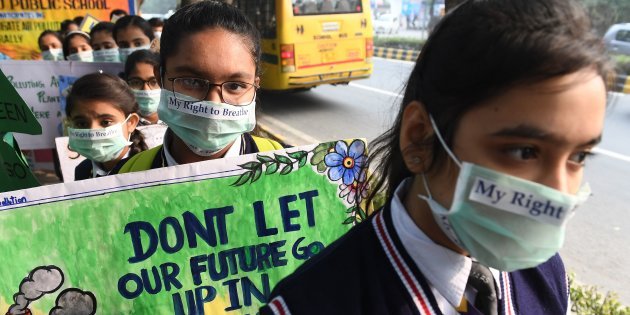

Indian children at risk
The researchers at the Indian Institute of Technology-Delhi, the Indian Statistical Institute Delhi Centre and the University of Texas at Austin explored how early-life exposure to outdoor PM2.5 impacts child health (height-for-age) in India in a study.
They found that that exposure of fetuses (in the last trimester of pregnancy) and newborns to PM2.5 particles is significantly associated with deficits in child height, which has lasting consequences for human capital and potential ramifications for the Indian society and economy.
The authors tapped into population data from the National Family Health Survey 2015-16 (NFHS-4) conducted by the Indian government which covered all 640 districts and surveyed nearly 225,000 children of both sexes. This was mapped against satellite data of monthly PM2.5 level for 15 years (2001–2015) for comparison with the month of birth.
The results show that if a five-year-old girl was born in a place where outdoor PM2.5 was 100 microgram/cubic metre lower than that it was in the place of her birth, she would have been 0.24 cm taller.
“Our results imply that while rural children in India might expect to arrest stunting due to better sanitation access from Swachh Bharat initiative, this benefit might not be realised if they remain exposed to high air pollution which would increase stunting,” study author Sagnik Dey IIT-Delhi’s Centre for Atmospheric Sciences said in a statement.
Three child health outcomes, height-for-age (a measure for stunting) weight-for-age (measure overweight) and weight-for-height (a measure of wasting) offer insights into how healthy their adult lives would be.
Dey argued it is extremely important for India to ensure successful implementation of India’s clean fuel programme (Pradhan Mantri Ujjwala Yojana), which will not only reduce household air pollution and cause a large improvement in ambient air pollution but also improve child health.
According to an Energy Policy Institute at the University of Chicago (EPIC) study, which developed the Air Quality Life Index (AQLI), on average, people in India would live 4.3 years longer if the country were to clean its air.
Past studies have looked into air pollution exposure during pregnancy and low birth weight outcome and have found how indoor (or household) air pollution and passive smoking impact stunting and other child health outcomes in various low and middle-income countries including Bangladesh.
Double Whammy for Indian Rural Children
The study underscored the rural-urban divide in air pollution and sanitation access, the seasonal interventions to reduce air pollution and additional vulnerability for children born to shorter mothers.
Although, in general, children in rural areas in India are shorter than their urban counterparts (because of poor sanitation and nutrition), when pollution level increases, rate of decrease in height-for-age is more-or-less similar in urban and rural children.
“This shows that rural children face a double whammy as they are more vulnerable to the combined effects,” said Dey.
The maximum effect of toxic air particles (height decline) is between November to January when the pollution level in India reaches its peak. So clearly, reducing pollution in this critical period is expected to have a much larger benefit at the population level, said Dey.
“When we sort the data as per mother’s height, we observe shorter mothers have shorter children. But pollution affects everyone in a similar manner. So children born to shorter mothers would be more vulnerable if born in a polluted environment,” he explained.
Of the total deaths in India in 2017, 1.24 million deaths, equivalent to 12·5 percent of total mortalities, could be attributed to air pollution, according to a India State Level Disease Burden Initiative report, published in The Lancet in December.
To read the study in detail click here
Picture Credit: Delhiair
In a significant move toward advancing green energy and industrial growth in the state, Himachal…
Golabl chemical conglomerate BASF has announced that its now offering the world’s first biomass-balanced polyethersulfone…
In a crucial stint to bolster the biogas sector and sustainable dairying in the country,…
TotalEnergies SE has received approval to proceed with its Middlebrook solar and battery project in…
Andhra Pradesh Chief Minister Chandrababu Naidu has inaugurated the Rs 1,000-crore green hydrogen plant of…
The BITS Pilani has developed an innovative solution for managing landfill leachate, domestic septage, and…